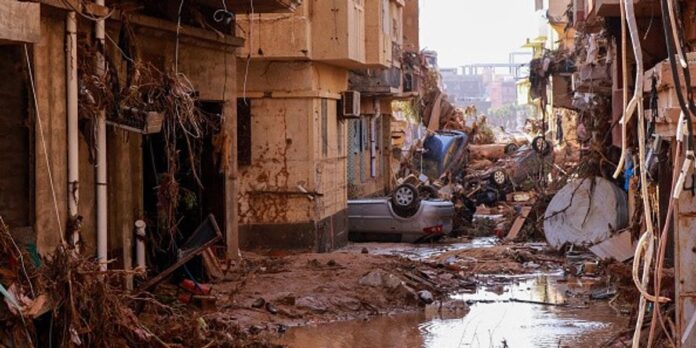“In places where systems have collapsed through no fault of local people,” said one advocacy group, “climate impacts are being experienced worse than anywhere.”
By JULIA CONLEY, Common Dreams
The Interior Ministry in eastern Libya said Tuesday that the confirmed death toll in flooding from Storm Daniel has risen past 5,200, with at least 10,000 people feared missing and at least a quarter of the Mediterranean port city of Derna destroyed, according to officials.
“Bodies are lying everywhere—in the sea, in the valleys, under the buildings,” Civil Aviation Minister Hichem Chkiouat told Reuters on Tuesday. “I am not exaggerating when I say that 25% of the city has disappeared. Many, many buildings have collapsed.”
Health Minister Othman Abdel Jalil told reporters that ultimately the number of deaths is expected to reach 10,000 following Daniel’s torrential downpour, which caused floodwaters to breach Derna’s two dams over the weekend.
Whole cities have been destroyed by phenomenally powerful storms in Libya. https://t.co/cSZHEuZf0K
— Extinction Rebellion Global (@ExtinctionR) September 12, 2023
The water reached as high as 10 feet in some parts of the city, witnesses told Reuters, washing away “entire neighborhoods” into the sea in just the latest of the extreme weather disasters that have devastated cities and killed thousands of people in recent months across the globe, as scientists have warned that extreme rainfall, heatwaves, and wildfires are being driven by the climate crisis and the extraction of fossil fuels.
The United Nations warned in 2020 that low-lying coastal areas of Libya are at an elevated risk for climate-related disasters as water in the warming Mediterranean Sea expands, causing sea levels to rise approximately 2.8 millimeters (0.1 inches) per year.
Storm Daniel also killed 15 people in Greece before making its way south to Libya; according to one expert at Britain’s University of Reading, such Mediterranean hurricanes—or medicanes—could become more deadly as the planet continues to grow hotter due to the emission of heat-trapping gases.
“There is consistent evidence that the frequency of medicanes decreases with climate warming, but the strongest medicanes become stronger,” meteorology professor Suzanne Gray told Reuters.
Christos Zerefos, secretary general of the Academy of Athens and head of the institution’s climatology research center, told the outlet that the rainfall that preceded the flooding was “unprecedented” for the North African country, with more rain dumped on Libya than ever recorded since data-collecting began in the mid-19th century.
“We expect such phenomena to happen more often,” he told Reuters.
The disaster was made worse in Derna by ongoing political turmoil in the country since a 2011 political uprising, with two separate governments overseeing the east and the west.
Hani Shennib, president of the National Council on U.S.-Libya Relations, told Al Jazeera that “the east has been neglected,” with Derna’s dams eroding and few health services to serve the city of 100,000 people.
Grassroots climate movement Extinction Rebellion Global noted that, as campaigners have long warned, people in cities where public services “have collapsed” are uniquely vulnerable to climate catastrophe.
The devastating floods came just over a week before world leaders are scheduled to meet in New York for the United Nations Climate Ambition Summit, where U.N. Secretary-General António Guterres has called on them to present updated commitments to reduce fossil fuel emissions and climate action plans, warning last week that recent extreme weather shows “climate breakdown has begun.”
“Governments must act now,” said Greenpeace International, “to end fossil fuels that are plunging us deeper into climate disaster every day.”



